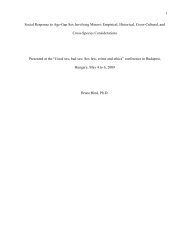Infant and Child Sexuality: A Sociological Perspective - Ipce
Infant and Child Sexuality: A Sociological Perspective - Ipce
Infant and Child Sexuality: A Sociological Perspective - Ipce
You also want an ePaper? Increase the reach of your titles
YUMPU automatically turns print PDFs into web optimized ePapers that Google loves.
infant.<br />
Not only the amount but also the nature of stimulation between the<br />
infant <strong>and</strong> mother is of consequence. When the infant is suckling he reciprocates<br />
by putting fingers into his mother’s mouth; she responds by<br />
moving her lips on his fingers. He moves his fingers; she responds with<br />
a smile. All the while he studies her face with rapt attention. (Spitz,<br />
1949, p. 291). <strong>Infant</strong>s pat the mother’s breast while sucking, pat her<br />
face, turn a cheek to be kissed, clasp her around the neck, lay their<br />
cheek on hers, hug, <strong>and</strong> bite. “Such little scenes can be observed in<br />
endless variations in any mother-child couple.” (Spitz, 1949, p. 291).<br />
Some of the expressions of affection through patting <strong>and</strong> hugging may be<br />
spontaneous, while others are learned in the infant’s encounters with<br />
mother <strong>and</strong> other adults. (Shirley, 1933).<br />
If a responsive woman is the mother of a non-cuddling infant considerable<br />
challenge is held out to her adaptability, as with a cuddly<br />
baby <strong>and</strong> a non-responsive mother. Some mothers make it clear that<br />
breast feeding is at best a duty <strong>and</strong> is not physically nor emotionally<br />
pleasurable. If the suckling experience seems unworthy or shameful to<br />
her, the mother may not be able to acknowledge it or may feel the need<br />
to find acceptable excuses. In the United States illness or physical<br />
inadequacy are commonly accepted as “good” reasons for not suckling infants.<br />
In contemporary United States’ culture, the breasts play a more<br />
prominent part in the erotic encounters of adults than they do in suckling<br />
experiences with infants. In societies where suckling is generally<br />
accepted, infant-mother separation is not easily tolerated by<br />
either participant. In speaking to G<strong>and</strong>a women, Ainsworth (1963) relates<br />
that a number of mothers said they enjoyed breast feeding, <strong>and</strong><br />
one confessed with embarrassment that it was so satisfactory to her<br />
that though her child was over twelve months of age she was reluctant<br />
to wean him. Mathews, in describing the infant-mother sensory contact<br />
among the Yorubas of Nigeria (as reported in Newton <strong>and</strong> Newton, 1967),<br />
reports that a strict breast feeding routine would be difficult to attain<br />
because the mothers, determined <strong>and</strong> obstinate, were not easily<br />
separated from their babies for long. The baby remains from birth until<br />
about the second year of life almost constantly in close physical<br />
contact with the mother who feeds it at irregular intervals, usually<br />
determined by the infant’s crying.<br />
Among the Dahomey, mothers regularly carry the infant about with<br />
them <strong>and</strong> the infant seldom has other nurses. Close bodily contact <strong>and</strong><br />
suckling is continued for two to three years. There is no cohabiting<br />
between husb<strong>and</strong> <strong>and</strong> wife during this period if the man has other wives.<br />
(Herskovits, 1952, p. 259ff). To what extent the infant becomes a<br />
“lover” surrogate in such long absences from marital coitus is a moot<br />
question. <strong>Infant</strong> <strong>and</strong> mother frequently stay in continuously close sensory<br />
contact in many societies characterized by late weaning.<br />
Besides the suckling encounters, in a few primitive societies,<br />
adults participate actively in the erotic stimulation of infants <strong>and</strong><br />
young children. This is less common in contemporary American society,<br />
but does occur as will be indicated later. Among the Kazak, adults who<br />
are playing with small children, especially boys, excite the young<br />
one’s genitals by rubbing <strong>and</strong> playing with them. Autogenital stimula-<br />
14
















